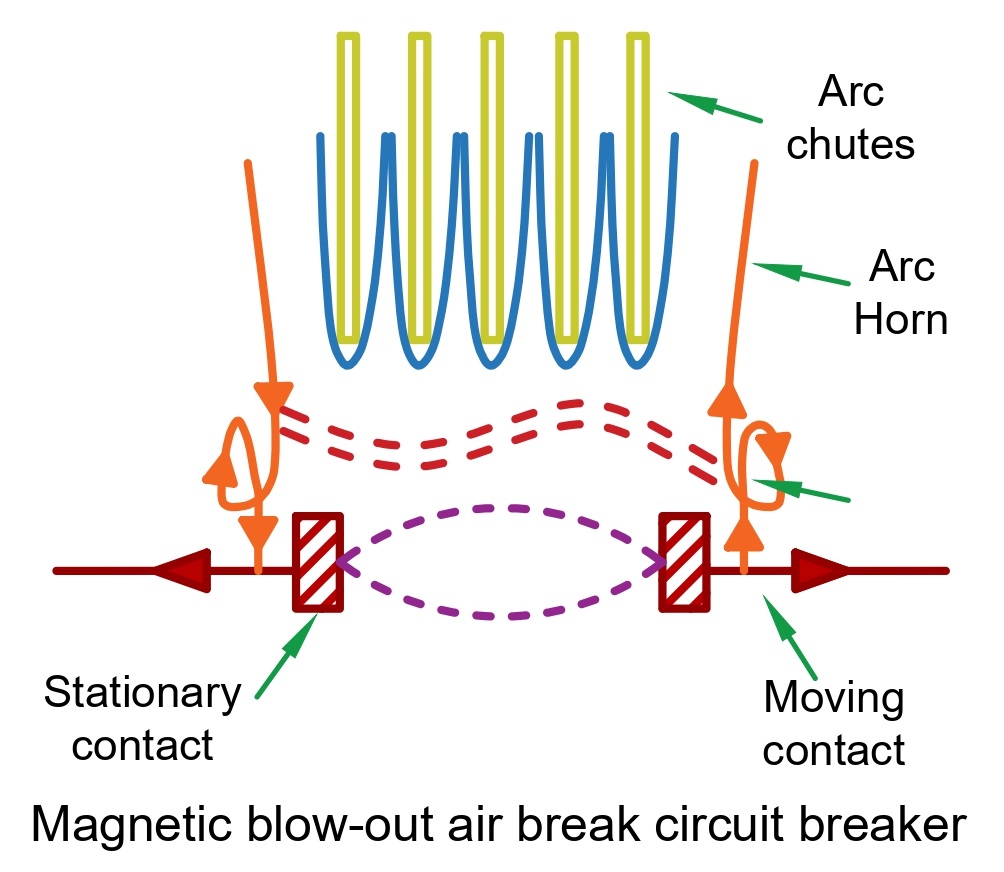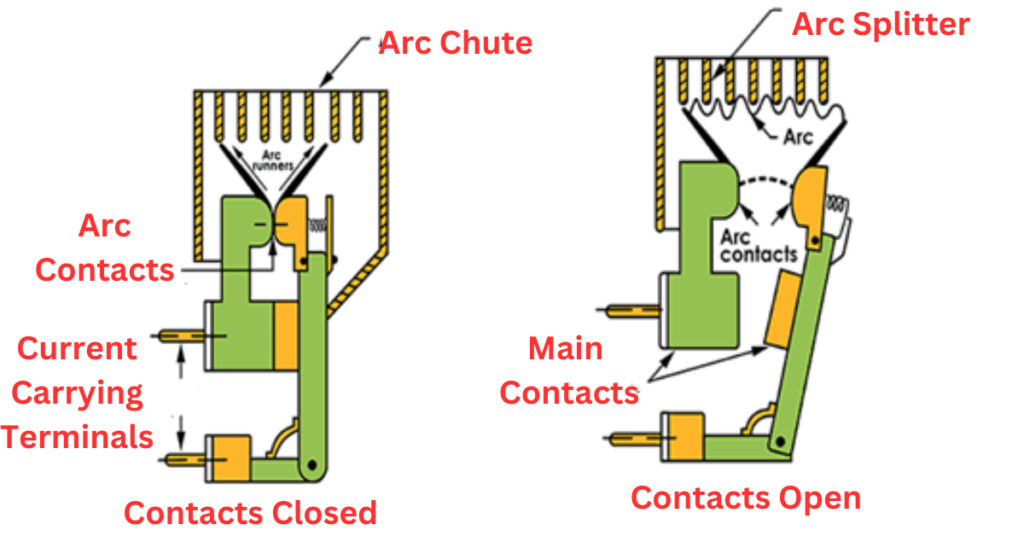The air break circuit breaker (commonly referred to as an Air Circuit Breaker or ACB) is designed to initiate and extinguish arcs in relatively still air. They are typically used for low voltages, usually up to 15KV, and have a rupturing capacity of 500MVA. Air circuit breakers have several advantages as an arc quenching medium compared to oil-based breakers. These are as follows.
- The elimination of risks and maintenance associated with the use of oil.
- The gas pressure and oil movement create no mechanical stress.
- Regular oil replacement costs are eliminated since the oil does not deteriorate with successive breaking operations.
The air break circuit breaker operates by separating the contacts and extinguishing the arc in the air at atmospheric pressure. This circuit breaker employs the high resistance principle and uses arc runners and arc chutes to expand the arc. The arc resistance is increased by splitting, cooling, and lengthening.
The voltage drop across the arc becomes greater than the system voltage, causing the arc to extinguish at the current zero of the AC wave due to increased arc resistance.
Air circuit breakers are used in both DC and AC circuits up to 12,000 volts. These breakers are typically of the indoor type and are installed on vertical panels or indoor draw-out switchgear. AC circuit breakers are commonly used in indoor medium-voltage and low-voltage.
Note: The terms “Air Break Circuit Breaker” and “Air Circuit Breaker” are used interchangeably in this article.
Components of an Air Circuit Breaker
Before understanding how an air circuit breaker works, it’s helpful to know its key components. Each part plays a crucial role in safely interrupting and isolating fault currents:
- Main Contacts – Carry the normal load current and open when a fault is detected.
- Arcing Contacts – Handle the arc during interruption, protecting the main contacts.
- Arc Chutes – Chambers where arcs are split and cooled to aid in extinguishing.
- Operating Mechanism – A spring or motor-operated system that controls opening/closing.
- Trip Unit – Detects abnormal conditions like overload or short-circuit and initiates trip.
- Blowout Coils – Generate magnetic force to drive the arc into the chute (used in magnetic types).
- Insulation – Prevents electrical flashovers between internal components.
- Auxiliary Contacts – Used for signaling or control in interlocking systems.
- Enclosure Frame – The external structure housing all internal parts safely.
Working Principle of Air Break Circuit Breaker
When a fault occurs, the first thing that happens is that the main contacts separate, and the current is shifted to the arcing contacts. Next, the arcing contacts separate, forming an arc between them. This arc is then forced upwards by electromagnetic forces and thermal action. The arc ends are directed along the arc runner and move upwards until they reach the arc splitter plates. Finally, the arc is extinguished by various methods, including lengthening, cooling, and splitting.
This working principle applies to all types of air circuit breakers used in low and medium-voltage systems.
Classification of Air Circuit Breaker Based on Arc Quenching Method
Plain Break Type Air Circuit Breaker (ACB)
It is the simplest type, with two horn-shaped pieces. When the air first moves between the horns, it is pushed upwards by the convection currents that occur due to the heating of the air during the arcing process and the interaction of the magnetic and electric fields. If the horns are fully separated, the arc will stretch from one tip to the other, causing the arc to become longer and cooler.
The possibility of slow arc spreading of adjacent metal works limits the application of circuits above 500V and too low power..
Magnetic Blow-Out Type Air Break Circuit Breaker
Air circuit breakers are used in circuits with voltage up to 11 KV. To extinguish arcs created during the interruption of the circuit, magnetic fields are generated by blowout coils connected in series. These are called blowout coils. The magnetic field doesn’t extinguish the arc by itself. Instead, it moves the arc into chutes, where it is lengthened, cooled, and eventually extinguished. Arc shields prevent the arc from spreading to an adjacent network.

To direct the arc upward, the coils must be connected with the correct polarity. As the breaking action becomes more effective with larger currents, this principle increases the rupturing capacities of such breakers to higher values.
The arc chute is essential for ensuring the safe and efficient operation of electrical systems. It performs three interrelated crucial functions by efficiently extinguishing arcs in the air.
- Confines the arc within a restricted space
- Provides magnetic control to ensure arc movement is contained and extinguished
- Quick cooling of arc gase ensures that the arc is extinguished by deionization.
Air Chute Air Circuit Breaker
The figure below shows the typical air-chute break circuit breaker setup for low- and medium-voltage circuits.

This breaker consists of two sets of contacts – the main contacts and the arcing or auxiliary contacts. The main contacts are made of copper and conduct current when the breaker is closed. They have low contact resistance and are plated with silver.
The arcing contacts are made of a hard, heat-resistant copper alloy. They are used to protect the main contacts from damage caused by arcing. When necessary, the arcing contacts can be easily replaced. During operation, the auxiliary and arcing contacts close before the main contacts and open after them.
The blowouts in this system consist of steel inserts placed in the arcing chutes. These inserts are arranged so that the magnetic field induced by the current in the arc moves it upwards at a faster rate. The steel plates divide the arc into multiple smaller arcs in a series.
The voltage distribution along the arc length is non-linear and is accompanied by significant anode and cathode drops. If the sum of anode and cathode drops of all the short arcs in series exceeds the system voltage, it automatically creates conditions for the arc to be quickly extinguished.
When the arc comes into contact with the relatively cool surfaces of the steel, it gets rapidly and effectively cooled. The movement of the arc may be natural or aided by a magnetic blowout. As a result, the arc is extinguished by reducing its power and increasing its loss.
To explore more ACB classifications based on poles, operation, trip types, breaking capacity, and more, visit our detailed guide on Types of ACB.
Applications of Air Circuit Breaker
The air break circuit breaker is ideal for controlling power station auxiliaries and industrial plants. It doesn’t need any additional equipment, such as compressors. As an air circuit breaker, it is particularly preferred where oil-based devices pose safety risks. They are commonly used in areas where fire or explosion hazards are present. The air break principle of lengthening the arc and utilizing arc runners and magnetic blow-up is employed for DC circuit breakers up to 15 KV.
Comparison with Other Circuit Breakers
- Air Circuit Breaker: Operates in systems rated up to 15 kV, especially in indoor medium-voltage installations.”
- Vacuum Circuit Breaker: Uses a vacuum; operates up to 38 kV; needs very little maintenance.
- Oil Circuit Breaker: Uses insulating oil; handles voltages up to 230 kV; has high maintenance needs.
Maintenance of Air Circuit Breakers
Proper maintenance keeps air circuit breakers reliable and safe. Follow these essential steps:
- Inspect the contacts regularly for wear or pitting.
- Align and check the arc chute to ensure proper function.
- Test the trip mechanism at scheduled intervals.
- Keep enclosure seals intact, especially for indoor use.
Drawbacks of Air Break Circuit Breaker
The arc chute principle, commonly used in air circuit breakers, has the disadvantage of being ineffective at low currents due to weak electromagnetic fields. Although the lengthening and deionizing action of the chute is not necessarily less efficient than at high currents, the arc movement into the chute tends to become slower, and high-speed interruption is not necessarily achieved.
Conclusion
Air Break Circuit Breakers (ACBs) play a crucial role in protecting electrical systems, especially in low to medium-voltage applications. They use air at atmospheric pressure to interrupt current flow and extinguish arcs effectively. By employing arc runners, chutes, and blow-out coils, ACBs ensure safe disconnection during faults.
Engineers and technicians prefer ACBs for their simple design, reliable performance, and minimal maintenance needs. When selecting a breaker, always consider the voltage rating, arc quenching method, and installation environment to ensure optimal performance.
FAQs
Air is used because it is readily available, cost-effective, and safe. Unlike oil, it doesn’t pose a fire hazard and requires less maintenance, making it ideal for low and medium-voltage applications.
The key difference lies in the arc extinguishing medium. Air circuit breakers use atmospheric air to quench the arc, while vacuum circuit breakers extinguish the arc in a vacuum, which offers faster recovery and minimal contact wear.
Air circuit breakers are typically designed for indoor applications. Their construction is better suited to protected environments such as panels or switchgear inside buildings. For outdoor use, vacuum or SF₆ breakers are often preferred.
Air circuit breakers are generally limited to low and medium voltage ranges, typically up to 12kV–15kV. For higher voltages, other types like SF₆ or vacuum circuit breakers are more suitable due to better arc control.
Maintenance frequency depends on the operating conditions and number of operations. However, periodic inspections every 6–12 months are recommended to check for contact wear, arc chute condition, and mechanical operation.
Related Articles: